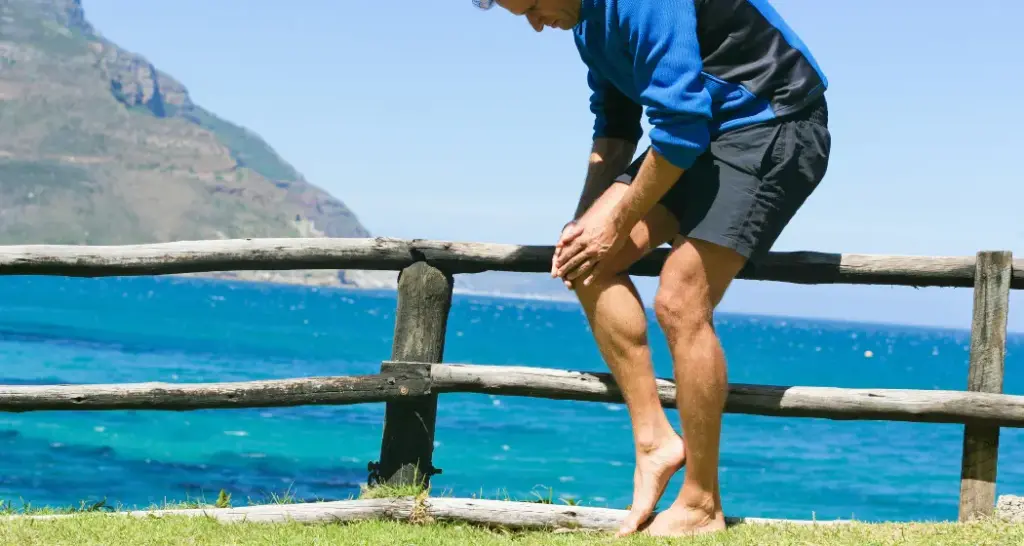Understanding Knee Pain in Bending: Types, Causes & Treatment
Types of Knee Pain While Bending: Knee pain while bending can manifest in several ways, such as pain above the kneecap, in front of the kneecap, behind the knee, or as a sharp pain during motion or while bending. Additionally, some individuals experience discomfort due to knee pain in bending, including pressure point knee pain, which can greatly affect both your mobility and quality of life.
Weight-bearing knee Pain: Experiencing knee pain while going up and down stairs, squatting, or sitting is often due to the weight and pressure placed on the knee. Extra weight compresses and stresses the knee joints and muscles, leading to discomfort and pain. This can also be linked to pressure point knee pain, where specific points around the knee are more sensitive to pressure.
Non-Weight Bearing Knee Pain: Knee pain can also occur without bearing weight, such as when moving your knee or standing on one leg. This type of pain might be associated with straightening the leg or specific knee movements that do not involve significant pressure.
Causes of Knee Pain in Bending Several factors can cause knee pain when bending, including:
- Arthritis: Degeneration of knee joint cartilage.
- Tendinitis: Swelling and irritation of the tendons of the tendons around the knee.
- Bursitis: Inflammation of the bursae, fluid-filled sacs that cushion the knee.
- Injuries: Ligament or meniscus tears can cause pain during movement.
Treatment Options Treating knee pain in bending requires a comprehensive approach:
- Physical Therapy: Strengthening and stretching exercises tailored to relieve pressure point knee pain and improve mobility.
- Medication: Anti-inflammatory drugs to reduce pain and swelling.
- Natural Remedies: Ice, heat therapy, and rest can provide relief for straightening leg knee pain.
- Weight Management: Reducing body weight to decrease stress on the knee joints.
- Regenerative Medicine: Therapy used to help regenerate affected tissue.
By understanding the types and causes of knee pain while bending, you can seek the most effective treatments and preventive measures to improve your knee health and overall quality of life.
What’s Causing Your Knee Pain When Bending?
Traumatic Injuries: Knee pain when bending can result from traumatic injuries, which are often easily identifiable. These injuries might occur during sports, work-related activities, or accidents. Typically, the knee swells and becomes painful about 24 hours after the injury.
Knee Bursitis: Knee bursitis involves inflammation of one or more bursa around the knee. These fluid-filled sacs reduce friction between bones and soft tissues. Excessive pressure or friction can inflame the bursa, causing knee pain in bending and making movement difficult.
Osteoarthritis: Osteoarthritis is common among older adults and involves the wear and tear of cartilage lining the knee joint. This degeneration can result in the development of bone spurs, causing significant knee pain. Symptoms often include pain when bending and stiffness when trying to straighten the leg.
Runner’s Knee: also known as patellofemoral patellofemoral pain syndrome, is a frequent cause of knee pain in bending. It occurs due to improper tracking of the kneecap, leading to increased friction on the cartilage. This condition causes pain at the front, below, and to the sides of the kneecap, often accompanied by a grinding sound during movement.

Baker’s Cyst: A Baker’s cyst is swelling in the semimembranosus bursa behind the knee, often resulting increased kneeling activities, bending activities and even from arthritis. This condition causes stiffness, knee pain, and a noticeable bulge at the back of the knee, making it painful to bend the knee.
Knee Sprain: A knee sprain happens when one of the four ligaments in the knee is overstretched or torn. This injury can result in inflammation and knee pain, especially when bending. It can also lead to increased instability. The severity of the pain depends on the extent of the ligament damage.
Meniscus Tear: A meniscus tear involves the degeneration or injury of the C-shaped cartilage in the knee. Torn fragments can become lodged in the joint, leading to pain, swelling, and reduced cushioning, causing difficulty in bending and straightening the leg.
Patellar Tendonitis: Patellar tendonitis, often seen in athletes who engage in jumping or kicking activities, involves small tears and inflammation in the tendon below the kneecap. This condition leads to knee pain in bending and stiffness, particularly prevalent among basketball and volleyball players.
Pressure Point Knee Pain: Certain points around the knee may be more sensitive due to various conditions. Identifying and treating these pressure points can help alleviate knee pain in bending and improve overall knee function.
Effective Treatments for Knee Pain in Bending
RICE Method The RICE method (Rest, Ice, Compression, Elevate) is a go-to recommendation for managing knee pain in bending and other physical injuries. Here’s how it works:
- Rest: Minimize weight-bearing activities to avoid straining your knee.
- Ice: Apply ice to the affected area for about 20 minutes, 3-4 times a day, to reduce inflammation.
- Compress: Use compression bandages to support the knee. Make sure the wrap is snug but not too tight, as it can restrict blood flow.
- Elevate: Keep your knee elevated above heart level as much as possible throughout the day to help reduce swelling.
Knee Strengthening Exercises: Incorporate basic exercises like kickbacks, bridge poses, and leg raises into your routine. These exercises help reduce pressure, enhance stability, and improve knee alignment, alleviating knee pain when bending and straightening the leg.
Massage: Massaging the affected area, particularly focusing on pressure point knee pain, can help relax the muscles, tendons, and ligaments. Techniques like trigger point therapy, Swedish massage, and deep tissue massage can significantly reduce pain and promote healing.
Physical Therapy: A physiotherapist can develop a customized exercise program to improve knee stability, mobility, and flexibility. Physical therapy may involve heat and cold therapy, chiropractic care, and other modalities to address knee pain in bending and straightening leg knee pain.
Knee Surgery: If conservative treatments don’t alleviate the symptoms, surgical options may be considered. Procedures like ACL reconstruction, meniscus repair, and knee replacement can effectively treat severe knee conditions.
Regenerative Medicine therapies: These treatments not only help alleviate pain, but they also help regenerate affected tissue. Treatments include ozone therapy, prolozone, platelet rich plasma therapy (PRP), and Human cellular tissue known as mesenchymal stem cells. These various therapies help the body regenerate and heal affected tissue.
SoftWave therapy: SoftWave Therapy is an innovative, non-invasive therapeutic device that uses a patented, revolutionary method of shockwave generation known as SoftWave Technology. This treatment helps reduce pain and inflammation, promotes the formation of new capillaries and stimulates your own bodies stem cells after 45 minutes. This is a great, non invasive treatment to help with knee pain.
Contact us today at Waters Edge Medical Clinic to learn more about how we can help you find relief and regain your mobility.
FAQs on Knee Pain in Bending
1. What are the typical causes of knee pain in bending? Knee pain in bending can result from various conditions, including ligament injuries, meniscus tears, bursitis, tendinitis, and osteoarthritis. Overuse, improper alignment, and traumatic injuries are also common contributors to pain experienced during knee flexion.
2. How can I effectively alleviate pressure point knee pain? Pressure point knee pain can be effectively alleviated through targeted therapies such as trigger point massage, deep tissue massage, and physical therapy. Additionally, SoftWave therapy, a noninvasive treatment that uses acoustic waves to stimulate healing, can reduce pain and inflammation in specific pressure points around the knee.
3. What exercises can help reduce knee pain in bending? Exercises like kickbacks, bridge poses, and leg raises are highly effective for reducing knee pain in bending. These exercises help strengthen the muscles around the knee, improve alignment, and enhance stability. Adding these exercises into your routine can greatly alleviate pain during knee flexion.
4. Can straightening leg knee pain be managed without surgery? Yes, straightening leg knee pain can often be managed without surgery through conservative treatments. The RICE method (Rest, Ice, Compression, Elevation), physical therapy, knee strengthening exercises, and anti-inflammatory medications can be highly effective. Additionally, Regenerative medicine, and SoftWave therapy can promote natural healing and pain relief without invasive procedures.
5. When should I consult a specialist for knee pain in bending? You should consult a specialist for knee pain in bending if the pain is severe, lasts for more than a few weeks, or is accompanied by symptoms like swelling, redness, or instability. A specialist can identify diagnose the cause of the pain and recommend appropriate treatments, such as physical therapy, medications, or advanced treatments like SoftWave therapy to ensure effective pain management and recovery.

